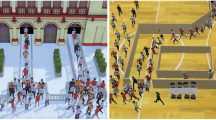Abstract
The quality of a crowd simulation model is determined by its agents’ local and global trajectory efficiency. While an agent-based model can accurately handle the local trajectories, global decisions usually are handled by a global path planner. However, most of the global path planning techniques do not consider other agents and their possible paths and the future global flow in the environment. In this paper, we propose a composite system that takes future agent configurations into account via a modified A* algorithm to create a global path plan and combines the global path plan with a local navigation model. We show that the agents using the proposed model intelligently plan their paths based on the dynamic configuration of the environment. In order to balance the performance vs. trajectory quality trade-off, we propose a hierarchical grid structure and discuss its effects on both trajectory quality and computational performance.











Similar content being viewed by others
References
Reynolds boids. http://www.red3d.com/cwr/boids/. Accessed 21 August 2014
RVO2 news. http://gamma.cs.unc.edu/RVO2/. Accessed 21 August 2014
van den Berg, J., Guy, S., Lin, M., Manocha, D.: Reciprocal n-body collision avoidance. In: Symposium on Robotics Research (2009)
Botea, A., Mller, M., Schaeffer, J.: Near optimal hierarchical path-finding. J. Game Dev. 1, 7–28 (2004)
Chen, D., Wang, L., Wu, X., Chen, J., Khan, S.U., Kolodziej, J., Tian, M., Huang, F., Liu, W.: Hybrid modelling and simulation of huge crowd over a hierarchical grid architecture. Future Gener. Comput. Syst. 29(5), 1309–1317 (2013)
Golas, A., Narain, R., Lin, M.: Hybrid long-range collision avoidance for crowd simulation. In: Proceedings of the ACM SIGGRAPH Symposium on Interactive 3D Graphics and Games, I3D ’13, pp. 29–36. ACM, New York (2013)
Guy, S., Chhugani, J., Curtis, S., Dubey, P., Lin, M., Manocha, D.: Pledestrians: a least-effort approach to crowd simulation. In: SCA’10, pp. 119–128. Switzerland (2010)
Guy, S., Chhugani, J., Kim, C., Satish, N., Lin, M., Manocha, D., Dubey, P.: Clearpath: highly parallel collision avoidance for multi-agent simulation. In: SCA’09, pp. 177–187. ACM, New York (2009)
Guy, S.J., Lin, M.C., Manocha, D.: Modeling collision avoidance behavior for virtual humans. In: Proceedings of the 9th International Conference on Autonomous Agents and Multiagent Systems: volume 2—volume 2, AAMAS ’10, pp. 575–582. International Foundation for Autonomous Agents and Multiagent Systems, Richland (2010)
Haciomeroglu, M., Barut, O., Ozcan, C.Y., Sever, H.: A gpu-assisted hybrid model for real-time crowd simulations. Comput. Graphics 37(7), 862–872 (2013)
Haciomeroglu, M., Laycock, R., Day, A.: Dynamically populating large urban environments with ambient virtual humans. Comput. Anim. Virtual Worlds 19(3–4), 307–317 (2008)
Kapadia, M., Beacco, A., Garcia, F., Reddy, V., Pelechano, N., Badler, N.I.: Multi-domain real-time planning in dynamic environments. In: Proceedings of the 12th ACM SIGGRAPH/Eurographics Symposium on Computer Animation, SCA ’13, pp. 115–124. ACM, New York (2013)
Kim, S., Guy, S.J., Manocha, D.: Velocity-based modeling of physical interactions in multi-agent simulations. In: Proceedings of the 12th ACM SIGGRAPH/Eurographics Symposium on Computer Animation, SCA ’13, pp. 125–133. ACM, New York (2013)
Morini, F., Yersin, B., Maïm, J., Thalmann, D.: Real-time scalable motion planning for crowds. In: Cyberworlds, pp. 144–152 (2007)
Narain, R., Golas, A., Curtis, S., Lin, M.: Aggregate dynamics for dense crowd simulation. ACM Trans. Graph. 28, 122:1–122:8 (2009)
Ondřej, J., Pettré, J., Olivier, A., Donikian, S.: A synthetic-vision based steering approach for crowd simulation. ACM Trans. Graph. 29, 123:1–123:9 (2010)
Patil, S., van den Berg, J., Curtis, S., Lin, M.C., Manocha, D.: Directing crowd simulations using navigation fields. IEEE Trans. Vis. Comput. Graphics 17(2), 244–254 (2011)
Pelechano, N., Allbeck, J., Badler, N.: Virtual Crowds: Methods, Simulation, and Control. Morgan & Claypool Publishers, USA (2008)
Pelechano, N., Allbeck, J.M., Badler, N.I.: Controlling individual agents in high-density crowd simulation. In: SCA’07, pp. 99–108. Switzerland (2007)
Ren, C., Yang, C., Jin, S.: Agent-based modeling and simulation on emergency evacuation. In: Zhou, J. (ed.) Complex Sciences, Lecture Notes of the Institute for Computer Sciences, Social Informatics and Telecommunications Engineering, vol. 5, pp. 1451–1461. Springer, Berlin, Heidelberg (2009)
Reynolds, C.W.: Flocks, herds and schools: a distributed behavioral model. In: SIGGRAPH, vol. 21, pp. 25–34 (1987)
Reynolds, C.W.: Steering behaviors for autonomous characters. In: Game Developers Conference ’09, pp. 763–782 (1999)
Ryder, G., Day, A.M.: Survey of real-time rendering techniques for crowds. Comput. Graphics Forum 24(2), 203–215 (2005)
Snape, J., Manocha, D.: Goal velocity obstacles for spatial navigation of multiple virtual agents. In: Proceedings of the 2013 International Conference on Autonomous Agents and Multi-agent Systems, AAMAS ’13, pp. 1191–1192. International Foundation for Autonomous Agents and Multiagent Systems, Richland (2013)
Thalmann, D., Grillon, H., Maim, J., Yersin, B.: Challenges in crowd simulation. In: International Conference on CyberWorlds, pp. 1–12. IEEE Computer Society, Bradford (2009)
Thalmann, D., O’Sullivan, C., Ciechomski, P., Dobbyn, S.: Populating virtual environments with crowds. In: Eurographics Tutorials. Vienna, Austria (2006)
Thalmann, N., Thalmann, D.: Virtual humans: thirty years of research, what next? Vis. Comput. 21(12), 997–1015 (2005)
van Toll, W., Cook IV, A., Roland, G.: Real-time density-based crowd simulation. Comput. Anim. Virtual Worlds 23, 59–69 (2012)
Treuille, A., Cooper, S., Popovic, Z.: Continuum crowds. In: SIGGRAPH, pp. 1160–1168. Boston, Massachusetts (2006)
Turkay, C., Koc, E., Balcisoy, S.: Integrating information theory in agent-based crowd simulation behavior models. Comput. J. 54(11), 1810–1820 (2011)
Xiong, M., Chen, Y., Wang, H., Hu, M.: A motion planning framework for simulating virtual crowds. In: Computational Intelligence and Intelligent Systems. Springer, Berlin. Heidelberg (2012)
Author information
Authors and Affiliations
Corresponding author
Electronic supplementary material
Below is the link to the electronic supplementary material.
Supplementary material 1 (wmv 5715 KB)
Rights and permissions
About this article
Cite this article
Ozcan, C.Y., Haciomeroglu, M. A path-based multi-agent navigation model. Vis Comput 31, 863–872 (2015). https://doi.org/10.1007/s00371-015-1110-2
Published:
Issue Date:
DOI: https://doi.org/10.1007/s00371-015-1110-2




